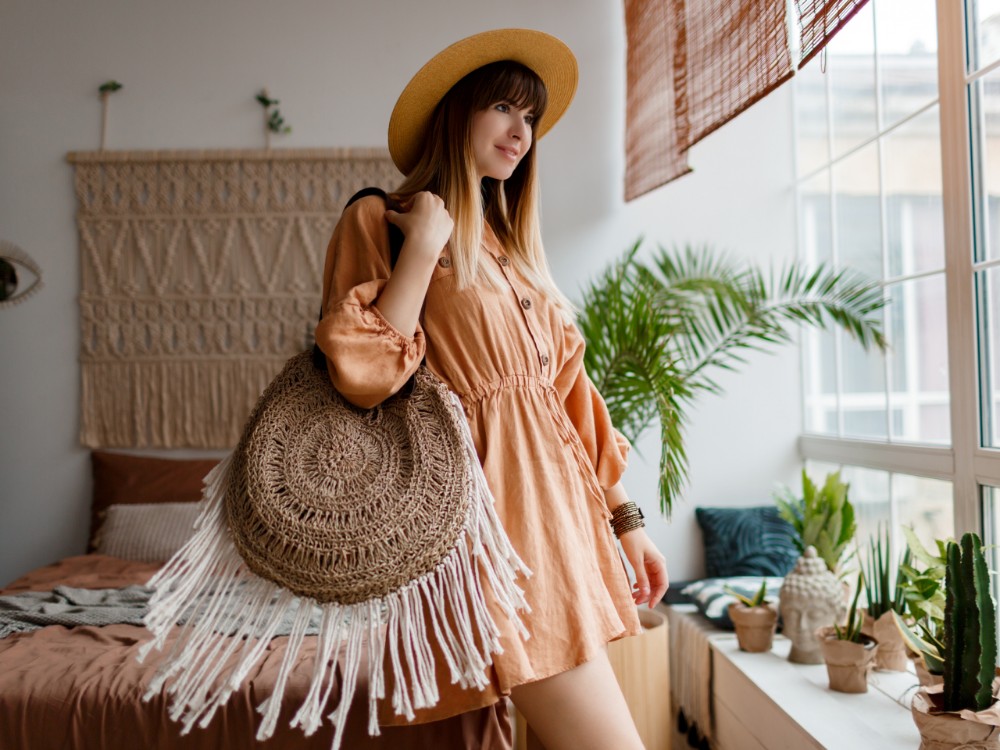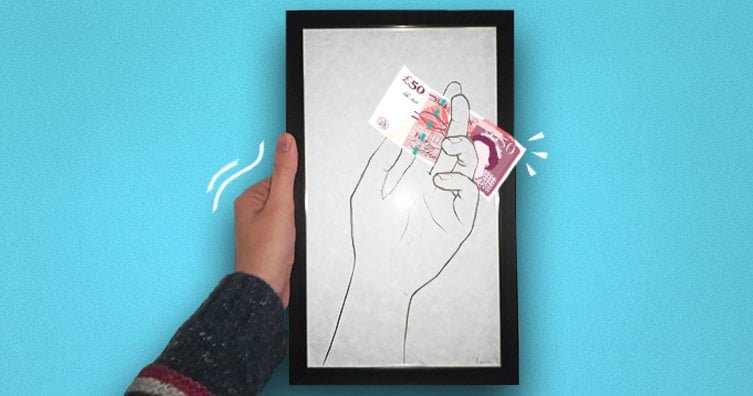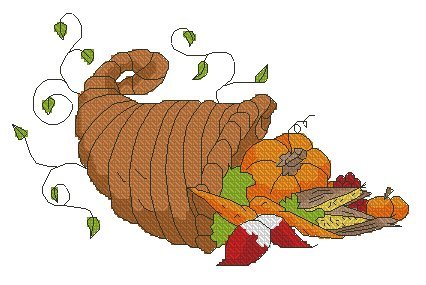Making money as an artist isn't always easy – particularly when you're first starting out. But selling art and earning an income from doing what you love really is possible. Here's how.
Credit: fratello (bank note), Lunatictm (background) – Shutterstock
If you're hoping to find a new loving home for your artworks, and make some money in the process, you've come to the right place.
There are so many great ways to sell art, including online, in galleries, at art fairs and even straight from your studio. The key to making a good income as an artist (as well as being super talented, of course), is finding out which approach to selling is most suited to you.
To help, we've gone through 12 of the best and most effective ways to sell art below.
Tips on selling art
- Best sites to sell art online
- Network with art buyers
- How to find a gallery for your art
- Sell via your artist website
- Win money in art awards and competitions
- Sell images of your art to stock websites
- Apply to sell at art fairs
- How to use social media to boost art sales
- Get more art commissions
- Create an art book
- Illustrate book covers for authors (full-time or freelance)
- Host open studio events
Doing these extracurricular activities can help you secure a job in the art industry. 🎨
12 best ways to make money as an artist
These are the easiest and most effective ways to sell art and earn money:
-
Apply to sell via art sites

Credit: WAYHOME studio – Shutterstock
If you haven't yet applied to join an art site as a seller, we'd definitely recommend it. It's up there as one of the very best ways to sell art online and make money.
To become a seller on some art-selling websites like Artsy and Artnet, you're required to have an established demand in the art market – but this isn't the case for all online marketplaces.
Here, we'll go through a couple of the top online art sites for independent and emerging artists: Artfinder and Saatchi Art.

Artfinder
Artfinder focuses on helping independent artists who are unrepresented by galleries find a platform to sell their art. If your application to sell art on Artfinder is successful, you'll be responsible for setting up your own listing and managing your art shop on the site.
Happy to take commissions? We'll talk about making money from art commissions in a bit more detail later, but this would be an option for you on Artfinder – you can highlight on your shop that you're open to commissions and buyers will be able to approach you to place orders.
There are the fees to be aware of for sellers on Artfinder:
- Starter Plan – You won't be charged monthly fees on this plan, but you'll be charged a 40% commission per sale*, and only be able to sell a maximum of 30 works before needing to upgrade the plan.
- Standard Plan – Commission goes down to 33% per sale*, but there is a monthly fee of £4. You can sell an unlimited number of artworks on this plan.
- Professional Plan – As with the Standard Plan, you'll need to pay a commission fee of 33% per sale*, and the monthly fee is £10. You can sell an unlimited number of works on this plan and it gives access to additional features like seeing artwork performance reports and platform sale trends.
* Commission is calculated based on the total artwork retail value (which you set) and does not include shipping fees.
The above fees are correct at the time of writing. To find out more about the plans on Artfinder, including a breakdown of which features are available with each one, click on the link below.

Saatchi Art
On their website, Saatchi Art describes itself as "the world's leading online gallery", making them a pretty great choice for any artist hoping to expand their audience (or any artist full stop, really).
Applying to start selling art online through Saatchi Art is pretty straightforward but, like with Artfinder, we recommend reading through their advicefor prospective sellers. In particular, be sure to give clear and detailed info about yourself, including your art education.
And, if you've exhibited your work in any physical art displays, definitely mention this.
At the time of writing, Saatchi Art doesn't charge monthly subscription costs but they usually will charge a 35% commission for each artwork sold. However, if you sell a limited edition print through Limited by Saatchi Art, the commission charges for these pieces will go up to 50%.
The charges apply to the profit on each sale (i.e. the final sale price, minus any production costs).
It's important to keep in mind that sometimes Saatchi Art runs promotional offers to collectors, potentially offering 10% – 20% off. The commission applies to the sale price, so if anyone buys a painting of yours at the reduced price, you would receive 65% of the amount that they pay.
The commission costs on art sites tend to be lower than in galleries (where it's often around 50%) – but you might miss out on unique opportunities.
-
Network with art buyers

Credit: DGLimages – Shutterstock
When you first start out as an artist, it can feel daunting to know where to begin meeting potential buyers for your art. Luckily, though, there are so many opportunities to meet art dealers and buyers – the important thing is to be confident.
Galleries usually host a fair amount of exhibition openings throughout the year. As an opportunity to get the first pick of new and exciting art, you can pretty much guarantee that they will attract keen buyers and collectors.
A lot of exhibition openings will be open to the public, but you'll usually need to RSVP to get added to the guest list. Check the gallery's social media and website for info about who to contact ahead of the event.
When you're there, talk to as many people as you can. It's also wise to arrive armed with images of your art to show, and maybe some business cards to hand out, too.
You're unlikely to make a sale there and then, but building up a network of potential buyers and other art enthusiasts is essential.
It could be that you meet somebody who is interested in buying one of your pieces. Or, you may even end up impressing the curators and directors at galleries, which could then lead to you actually consigning your work to them (i.e. agreeing for them to represent and sell your work) – which brings us to our next point…
If you're looking for new business cards, try sites like Vistaprint and Moo which have a huge range of design options to choose from.
-
Approach commercial galleries
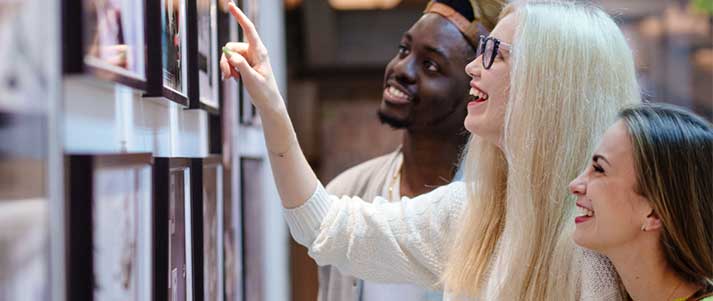
Credit: Iryna Inshyna – Shutterstock
When attending exhibition events, talk to as many people as you can – including the directors and curators of the gallery.
While they might not necessarily decide to start representing your artwork after the first meeting, taking the time to build up a relationship with them could really help. Show an interest in the works that they're showing, ask lots of questions and become a familiar face at their exhibition openings.
Even if they don't think you're ready for gallery representation right now, this in itself is a great chance to find out what you could do to develop your work.
Artists who are represented by well-established galleries can access some amazing opportunities, such as having their work exhibited at major art fairs, getting interviewed by art critics and having their art promoted by a trusted name to potential buyers.
However, these opportunities usually come at the cost of quite high commission costs – it can vary, but art gallery commission rates are often around 50% of sales.
If you think the suggested commission charges are too high, before signing anything, try to haggle the fees down in the contract between you (the artist) and the gallery.
-
Create a strong portfolio website
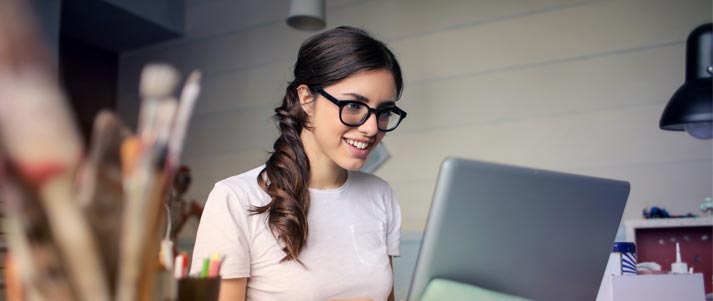
Whether you're first starting out or you've already made a name for yourself, creating an artist portfolio website that showcases your work is a very good way to boost your art sales online.
Not sure where to start? It's super easy to create a website using sites like Bluehost (you can get a 60% discount and free domain name with our link). Our guide to starting a website in 20 minutes explains the key things to know.
When developing your website, be sure to include lots of high-quality photos of your artworks and make the site visually appealing – it needs to reflect your artistic skills.
It's definitely worth adding an 'about me' page with a bit of insight into your artistic background and interests, including info about your education if you study a relevant subject like fine art, graphic design, textiles or art history.
As well as using the site to present your credentials, give a little insight into your personality, too. Try to write the site's copy in a tone and style that feels natural to you – art is, after all, very personal, and potential buyers will likely be keen to know about the real person behind the artworks.
Once your website is set up and you're ready to start selling art online, clearly highlight which artworks are for sale, how much they cost to buy and info on how people can contact you. It's a good idea to have a contact form on the site, as well as your number, email address and links to your social media profiles.
-
Enter art awards and competitions

Credit: Makalish Andrey – Shutterstock
Although this one's not technically a tip about selling art, entering art awards and competitions can be a brilliant (and lucrative) way to make money as an artist.
There are art competitions happening throughout the year, many of which come with cash prizes of hundreds, or even thousands, of pounds.
While it's not necessarily easy to win money in competitions, it really can be done – remember that someone's got to win!
It's essential to read the brief carefully. The key to standing out in art competitions is creating a piece that fits the judges' criteria, but is still creative, unique and extremely high-quality so that, out of potentially hundreds of submissions, yours is the one they remember.
Talented at crafts? Check out our list of the best things to make and sell.
-
Sell images of your art to stock websites

Credit: KaptureHouse – Shutterstock
It's not just your photographs that you can sell to stock-image websites. If you make any form of visual art, whether illustrations, fine art paintings or videography, you have the chance to sell your artwork online as stock images and videos.
Have a look through the images on sites like Shutterstock and Alamy, and you'll be able to find loads of pictures of artworks that artists are selling through the site. This can vary from detailed portraits to abstract designs, to painted blocks of colour that stock-image buyers can use as backgrounds in digitally edited pictures.
It's important to remember that as a stock image seller you wouldn't have control over who buys a licence to use the image, or where the image is used (e.g. it could be used in adverts for products that you wouldn't choose to promote).
Also, if you have any artworks that you wish to sell as original works of art, we would strongly advise against submitting images of them to stock image websites. This would become complicated when selling the physical piece as you couldn't quite promise the buyer full 'ownership' of the work if numerous others have also bought a license to use an image of it.
That said, it would be an amazing way to sell digital art, where the artwork doesn't have the same physical existence as, say, a painting on canvas.
So, while this can be a great way to earn a passive income from your art for some artists, it won't be right for everyone. If you're focusing on selling original works of art, we'd recommend trying some of the other points in this list instead, like this next one…
On Alamy, students at participating unis can keep 100% of the sales price of their images for two years. Find out more about this and see more top stock image sites here.
-
Apply to sell at art fairs

Credit: Padmayogini – Shutterstock
Art fairs are very big events in this industry. The top fairs will attract some of the most influential people in the art world, including art dealers, gallerists, curators and artists, but there will also be plenty of casual art fans who attend them as days out.
Unless you're already represented by an art gallery, you're not usually able to exhibit your work at Frieze and London Art Fair (arguably two of the most well-known art fairs in the UK), but there are some that accept applications from individual artists or artist collectives.
The Other Art Fair is worth applying for as an artist. It's presented by Saatchi Art and runs fairs across the world, including in London. Keep an eye on their website and social media channels to find out when applications for artists are open.
To find art fairs that are local to you, have a quick look on Google and identify ones that you think would suit you and your artwork. Each fair's website should include details about whether applications are open to individual artists, along with guidance on how to apply.
If you do manage to secure a place to exhibit your work at an art fair, be sure to be open and friendly throughout the day and chat with as many visitors as you can. It'd be ideal to arrange sales on the day, but try not to be disheartened if this doesn't happen.
Deciding whether to buy a work of art (particularly if it's got a high sales price) can take time – make sure you hand out business cards to anyone you chat with at the fair, and once visitors have had time to think through the decision, they may hopefully get back in touch to buy your art.
-
Promote and sell your artwork on social media

Credit: Flamingo Images, Pinone Pantone, Avector – Shutterstock
When you're first establishing your art career, it's pretty much essential to have an online presence to widen your audience and be easily contactable by potential art buyers.
TikTok and Instagram are focused on visual media, making them excellent ways for artists to sell art online. They allow you to show your work to thousands of people around the world who would have otherwise had very slim chances of discovering your work.
That said, selling art on Instagram, Facebook and other social media channels isn't always easy. A lot of time and effort needs to go into maintaining successful business accounts.
And, on top of this, social media is notorious for being distracting and can harm your productivity levels if you're not careful.
Essentially, when using social media to attract new fans to your art and increase your sales, you need to approach it as part of your job as an artist. Be savvy with it and keep the focus on selling your art, making sure your social media content is engaging and reflective of your work.
Once your portfolio website is set up, be sure to link to it from your social media profiles.
-
Get more art commissions
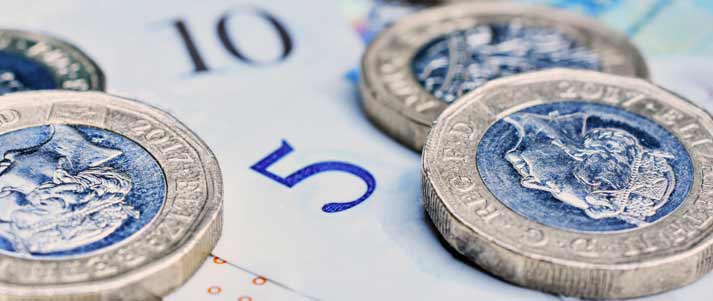
Credit: Ubermensch Matt – Shutterstock
If you don't already, a brilliant way to boost your sales is by taking paid art commissions from friends, family and members of the public.
The first step to getting art commissions is to let people know that you're open to creating made-to-order artworks. For example, if you have a social media page dedicated to your art, adding something like "DM me for commissions" is a simple but effective way to encourage people to get in touch.
Also, the more commissions you do, the better your chances of selling further personalised artworks – when you complete commissions, share examples on social media and your website, posting reviews from happy customers alongside them.
To improve the commercialisation of your art further, it can help to find a niche to focus on for art commissions. For example, if you're skilled at achieving likeness when drawing or painting animals, you could begin taking commissions for pet portraits.
You could even start selling art on Etsy, highlighting on your listings that you are able to personalise the artworks for the buyer.
Remember that if you're earning cash as a self-employed artist, you'll need to fill out a self-assessment tax return each year.
-
Create an art book

Credit: Unuchko Veronika – Shutterstock
If you've got a strong (and pretty sizeable) body of work, an art book could be the perfect way to sell your art without actually parting ways with all of the original pieces.
This could be a book entirely made up of images of your art but, if you feel confident to add your own writing alongside the images, this could really help to widen its appeal.
It would be an option to apply for book deals. However, unless you're already very well-established as an artist, it would probably be quite tricky to attract the attention of publishers and convince them to publish a book about your art.
Instead, we recommend self-publishing an eBook and following our top tips on how to monetise it.
-
Illustrate book covers

Credit: BongkarnGraphic – Shutterstock
If you don't fancy the idea of creating an entire book or eBook, why not design the cover of a book for someone else?
Working as a book cover designer can be a full-time career, but it can also be an ideal way tomake money in your spare time on a freelance basis.
To find authors who are keen to hire people to book cover designers, you could advertise your freelance design services on Fiverr.
There are lots of ads on there by book cover designers. To stand out, include a few images that reflect your design style and skills and research what the going rate is among other freelancers.
To secure more gigs on Fiverr, you'll want to charge a fee that is reasonable and reflective of the quality of your work, but still competitive compared to the other freelancers on the site.
-
Host open studio events

Credit: LightField Studios – Shutterstock
If you're fortunate enough to have an art studio, whether one that's just used by you or shared with other artists, opening it up to visitors for the day would be a great way to meet new potential buyers.
This would allow you to cut out third parties and arrange sales directly with buyers – meaning you can sell your art for free, without any fees.
It's a good idea to open up the studio on an RSVP basis.
By asking people to confirm in advance that they'd like to view your studio, you could arrange for different people to attend at different parts of the day. This way, at any one time, you'd be able to chat properly with each visitor – hopefully increasing your chances of fully engaging with a buyer and selling your art.
At an open studio event, we'd recommend displaying a mix of finished works that are available for sale, as well as some works in progress.
Visitors will likely be keen to know how you work, what your creative process is like and what to expect from your finished art pieces – as well as, of course, how to buy your art.
Ever considered selling art on Amazon Handmade? See our guide to making money on Amazon to find out more.

